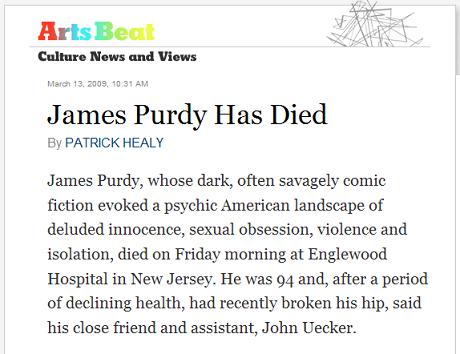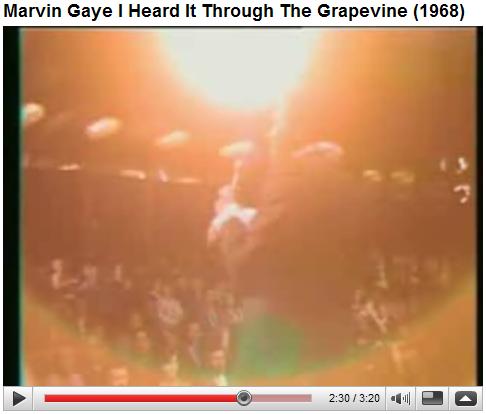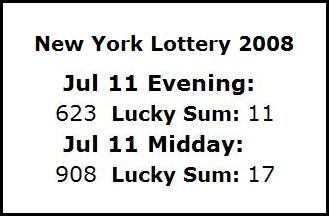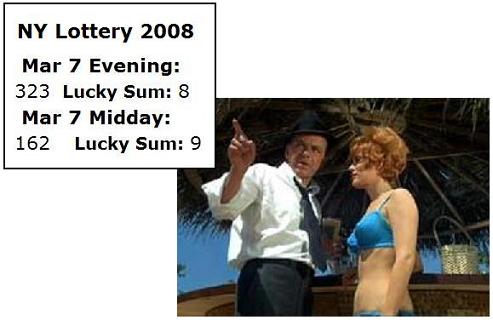Saturday, November 27, 2021
Marcela Nowak today —


See as well Polite Number.
Scholium:
"She was a very nice, polite little kid. God, I love it
when a kid’s nice and polite when you tighten their skate
for them or something. Most kids are. They really are.
I asked her if she’d care to have a hot chocolate or something
with me, but she said no, thank you. She said she had to meet
her friend. Kids always have to meet their friend. That kills me."
— Jerome Salinger, The Catcher in the Rye
Comments Off on Tag Shopping on Black Friday
Friday, December 1, 2023


Flattery might get you somewhere, my dear.
* Title suggested by a Robert A. Heinlein book —

Comments Off on His Girl Friday*
Friday, October 13, 2023

For a different sort of Lightbox, more closely associated with
the number 13, see instances in this journal of . . .

(Adapted from Encyclopaedia Britannica,
Eleventh Edition (1911), Crystallography .)
"Before time began . . . ." — Optimus Prime
Comments Off on Lightbox for a Friday the 13th
Friday, August 18, 2023
Comments Off on Double Feature — The Front Page/His Girl Friday
Monday, April 3, 2023

The above release date, April 7, is Good Friday in 2023.
An earlier (2006) Good Friday film —
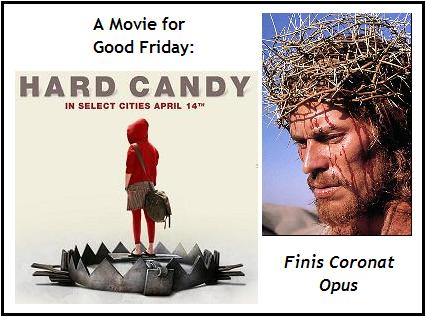
Comments Off on The Good Friday Film Festival continues.
Thursday, January 20, 2022

"Howard Solomon was building the pharmaceutical company
Forest Laboratories, not by manufacturing drugs but by
licensing them. In his search for deals in the United States and
Europe, he learned about citalopram, a Danish antidepressant."
— Richard Sandomir, New York Times , Friday, Jan. 14, 2022
" '… he’d talk about Verdi writing "Falstaff" in his 80s,' Andrew Solomon
said. ' "Imagine that," he’d say, "in his 80s, he wrote some of the greatest
music ever written." That was the path he hoped to follow.' ”

Comments Off on The Solomon Pill
Friday, December 10, 2021
Comments Off on Eclectic Friday
Sunday, October 27, 2019
Entertainment from NBC on Friday night —

The above question, and Saturday morning's post on a film director
from Melbourne, suggest an image from December's Melbourne Noir —

(March 8, 2018, was the date of death for Melbourne author Peter Temple.)
Comments Off on Friday Night Lights
Wednesday, February 13, 2019

"The purpose of mathematics cannot be derived from an activity
inferior to it but from a higher sphere of human activity, namely,
religion."
— Igor Shafarevitch, 1973 remark published as above in 1982.
"Perhaps."
— Steven H. Cullinane, February 13, 2019
|
From Log24 on Good Friday, April 18, 2003 —
. . . What, indeed, is truth? I doubt that the best answer can be learned from either the Communist sympathizers of MIT or the “Red Mass” leftists of Georgetown. For a better starting point than either of these institutions, see my note of April 6, 2001, Wag the Dogma.
See, too, In Principio Erat Verbum , which notes that “numbers go to heaven who know no more of God on earth than, as it were, of sun in forest gloom.”
Since today is the anniversary of the death of MIT mathematics professor Gian-Carlo Rota, an example of “sun in forest gloom” seems the best answer to Pilate’s question on this holy day. See
The Shining of May 29.
“Examples are the stained glass windows
of knowledge.” — Vladimir Nabokov
AGEOMETRETOS MEDEIS EISITO
Motto of Plato’s Academy
† The Exorcist, 1973
|
Detail from an image linked to in the above footnote —

"And the darkness comprehended it not."
Id est :
A Good Friday, 2003, article by
a student of Shafarevitch —

"… there are 25 planes in W . . . . Of course,
replacing {a,b,c} by the complementary set
does not change the plane. . . ."
Of course.
See. however, Six-Set Geometry in this journal.
Comments Off on April 18, 2003 (Good Friday), Continued
Sunday, November 5, 2017
Friday, February 24, 2017
An arXiv article from Good Friday, 2003, by Igor Dolgachev,
a student of the late Igor Shafarevich (see previous post) —

See also my Dec. 29, 1986, query on Duality and Symmetry.
Comments Off on Abstract Configurations on Good Friday
Sunday, September 4, 2016
Quoted here at 10 PM Pacific Time on Friday night —
"If I should die before I wake,
All my bone and sinew take
Put me in the compost pile
To decompose me for a while . . . ."
— Poem by Lee Hays



Comments Off on Piled High and Deep
Thursday, July 2, 2015
(Continued from Friday, June 26, 2015)
In memory of an architect —
Donald Wexler, an architect whose innovative steel houses
and soaring glass-fronted terminal at the Palm Springs
International Airport helped make Palm Springs, Calif.,
a showcase for midcentury modernism, died on Friday
[June 26, 2015] at his home in Palm Desert. He was 89.
— William Grimes in this morning's New York Times
For a different sort of architecture in Palm Desert, see…

Comments Off on Deepening the Spielfeld
Friday, May 8, 2015
Review:
Illustrating the Spiegel-Spiel des Gevierts
|
"At the point of convergence
the play of similarities and differences
cancels itself out in order that
identity alone may shine forth.
The illusion of motionlessness,
the play of mirrors of the one:
identity is completely empty;
it is a crystallization and
in its transparent core
the movement of analogy
begins all over once again."
— The Monkey Grammarian
by Octavio Paz, translated by
Helen Lane
|
Comments Off on Spielraum
Friday, November 28, 2014
Kristen Wiig, Girl Reporter…
.. in The Skeleton Twins—

"I've got news for you."
Co-starring Bill Hader as Her —

Comments Off on For Black Friday
Sunday, May 4, 2014


See also…

and … in this journal, the author of The Plumed Serpent.
Comments Off on Good Friday, 2007
Tuesday, April 10, 2012
|
Edward Reed Whittemore Jr. was born
on Sept. 11, 1919, in New Haven,
where his father was a doctor.
He earned a bachelor’s degree in English from Yale.
As a sophomore there, with his roommate
James Jesus Angleton (who would later become
the Central Intelligence Agency’s counterintelligence chief),
he founded a literary magazine, Furioso.
— The New York Times
|
In memoriam:
PART I —

PART II —
- Computers in "23"
- Der Einsatz
- The Borges Compass
Comments Off on Death on Good Friday
Monday, October 17, 2011
Pandemonium

Comments Off on Friday Night Lights…
Saturday, May 14, 2011
Yesterday's New York Lottery— Midday 346, Evening 104.
Interpretations:
346 as a page number. See The Storyteller in Chance (March 22, 2009), with its "spinning wheel" link to a passage by Joan Didion.
104 as a date. See 1/04/11— Didion on "a certain vertiginous occlusion of the imagined and the real" in the post The White Itself.
Comments Off on Friday the 13th Lottery
Sunday, January 16, 2011
On a conference at the New School for Social Research on Friday and Saturday, December 3rd and 4th, 2010—
"This conference is part of the early stages in the formation of a lexicon of political concepts. It will be the 5th in a series of conferences started in Tel Aviv University. The project is guided by one formal principle: we pose the Socratic question "what is x?", and by one theatrical principle: the concepts defined should be relevant to political thought…."
[The conference is not unrelated to the New York Times philosophy series "The Stone." Connoisseurs of coincidence— or, as Pynchon would have it, "chums of chance"— may read the conclusion of this series, titled "Stoned," in the light of the death on December 26th (St. Stephen's Day) of Matthew Lipman, creator of the "philosophy for children" movement. Many New York Times readers will, of course, be ignorant of the death by stoning of St. Stephen

Beloit College Nuremberg Chronicle
commemorated on December 26th. They should study Acts of the Apostles— Chapter 6 and Chapter 7.]
Meanwhile, in this journal—
Click to enlarge

For some background on the Dec. 4th link to "Damnation Morning," see "Why Me?"
For some political background, see "Bright Star"+"Dark Lady" in this journal.
* The title refers to a story by Fritz Leiber.
Comments Off on The Mind Spider*
Friday, November 27, 2009


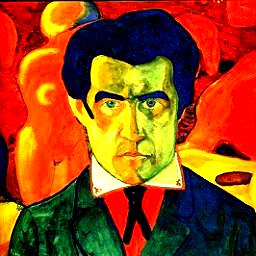
Black Square,
Black Cross,
Malevich
Related material:
Eid al-Adha,
The Social Aspect of Eid, and
Homage to Malevich
Comments Off on Black Friday
Friday, October 9, 2009
Identity:

"…strict grids of nine pictures
establish an egalitarian
framework…."
— Christopher Knight
Some are more
egalitarian
than others.
Comments Off on Friday October 9, 2009
Friday, September 25, 2009
Comments Off on Friday September 25, 2009
Friday, September 18, 2009
An Alternative
to the worldview
of Dan Brown:

Comments Off on Friday September 18, 2009
Friday, September 11, 2009
Comments Off on Friday September 11, 2009
Theology
in memory of
physicist Aage Bohr,
who died at 87 on
Tuesday, Sept. 8, 2009
Swarthmore physics honors thesis, 136 pp., 2007–
Abstract:
"Quantum mechanics, which has no completely accepted interpretation but many seemingly strange physical results, has been interpreted in a number of bizarre and fascinating ways over the years. The two interpretations examined in this paper, [Aage] Bohr and [Ole] Ulfbeck's 'Genuine Fortuitousness' and Stuckey, Silberstein, and Cifone's 'Relational Blockworld,' seem to be two such strange interpretations; Genuine Fortuitousness posits that causality is not fundamental to the universe, and Relational Blockworld suggests that time does not act as we perceive it to act. In this paper, I analyze these two interpretations…."
Footnote 55, page 114:
"Thus far, I have been speaking in fairly abstract terms, which can sometimes be unhelpful on the issue of explaining anything about the structure of space-time. I want to pause for a moment to suggest a new potential view of the blockworld within a 'genuinely fortuitous' universe in more visual terms. Instead of the 'static spacetime jewel' of blockworld that is often invoked by eternalists to help their readers conceptualize of what a blockworld would 'look like' from the outside, now imagine that a picture on a slide is being projected onto the surface of this space-time jewel."
From the perspective of one inside the jewel, one might ask 'Why is this section blue while this section is black?,' and from within the jewel, one could not formulate an answer since one could not see the entire picture projected on the jewel; however, from outside the jewel, an observer (some analogue of Newton's God, perhaps, looking down on his 'sensorium' from the 5th dimension) could easily see the pattern and understand that all of the 'genuinely fortuitous' events inside the space-time jewel are, in fact, completely determined by the pattern in the projector."
— "Genuine Fortuitousness, Relational Blockworld, Realism, and Time" (pdf), by Daniel J. Peterson, Honors Thesis, Swarthmore College, December 13, 2007
Comments Off on Friday September 11, 2009
Friday, September 4, 2009
Closing the Circle
Continued from Monday
“This is a chapel
of mischance;
ill luck betide it, ’tis
the cursedest kirk
that ever I came in!”
Philip Kennicott on
Kirk Varnedoe in
The Washington Post:
“Varnedoe’s lectures were
ultimately about faith,
about his faith in
the power of abstraction,
and abstraction as a kind of
anti-religious faith in itself….”
Kennicott’s remarks were
on Sunday, May 18, 2003.
They were subtitled
“Closing the Circle
on Abstract Art.”
Also on Sunday, May 18, 2003:
“Will the circle be unbroken?
As if some southern congregation
is praying we will come to understand.”
Princeton University Press:
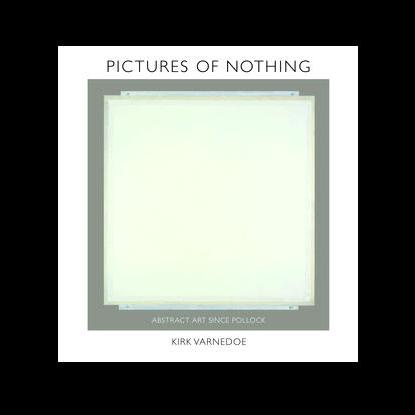
See also
Parmiggiani’s
Giordano Bruno —

Dürer’s Melencolia I —

and Log24 entries
of May 19-22, 2009,
ending with
“Steiner System” —

George Steiner on chess
(see yesterday morning):
“There are siren moments when quite normal creatures otherwise engaged, men such as Lenin and myself, feel like giving up everything– marriage, mortgages, careers, the Russian Revolution– in order to spend their days and nights moving little carved objects up and down a quadrate board.”
Steiner continues…
“Allegoric associations of death with chess are perennial….”
Yes, they are.
April is Math Awareness Month.
This year’s theme is “mathematics and art.”

Cf. both of yesterday’s entries.
Comments Off on Friday September 4, 2009
Friday, August 28, 2009
Part I:
“Inside the church, the grief was real. Sen. Edward Kennedy’s voice caught as he read his lovely eulogy, and when he was done, Caroline Kennedy Schlossberg stood up and hugged him. She bravely read from Shakespeare’s ‘The Tempest‘ (‘Our revels now are ended. We are such stuff as dreams are made on‘). Many of the 315 mourners, family and friends of the Kennedys and Bessettes, swallowed hard through a gospel choir’s rendition of ‘Amazing Grace,’ and afterward, they sang lustily as Uncle Teddy led the old Irish songs at the wake.”
— Newsweek magazine, issue dated August 2, 1999
Part II:
The Ba gua (Chinese….) are eight diagrams used in Taoist cosmology to represent a range of interrelated concepts. Each consists of three lines, each either ‘broken’ or ‘unbroken,’ representing a yin line or a yang line, respectively. Due to their tripartite structure, they are often referred to as ‘trigrams’ in English. —Wikipedia
Part III:

Above: detail from the cover of…
Comments Off on Friday August 28, 2009
Friday, August 14, 2009
Week Seven – Imagine…
Friday, August 14, 2009 @ 10:45 a.m.
“Amphitheater – George Kembel –
George Kembel is a co-founder and currently the executive director of the Stanford d.school, also known as the Hasso Plattner Institute of Design at Stanford University….”
Background:
“Plattner is said to be the 11th richest man in Germany with an estimated fortune of 5 billion USD, according to Forbes….
Plattner is a major owner of the San Jose Sharks hockey team….”
Comments Off on Friday August 14, 2009
Comments Off on Friday August 14, 2009
Friday, August 7, 2009
Angel and Beast
Screenwriter Frank Pierson spoke at
Chautauqua Institution this morning.
The gist of his remarks may be found
in an undated graduation speech
at WarnerSisters.com.
His suggested motto for filmmakers:
"To reach and touch
the angel in the beast."
The Chautauquan Daily,
Friday, August 7, 2009
by Sara Toth, staff writer —
"Pierson listed his favorite movies as
the Italian and French films that, after
World War II, captivated him and his
friends.
'Those movies were overwhelmingly
fascinating to us, and changed the way
in which we saw movies, and the way we
saw our lives and what we wanted to do
with ourselves,' he said. 'There were so
many that were absolutely marvelous.'
Such movies are not made any
more, Pierson said, and the quality
of the movies now pale in comparison
to those of the 1970s and 1980s.
About once a year, the Coen brothers
release a movie, and Woody Allen
'occasionally' makes a good film,
Pierson said. But the mainstream movies
that are shown in the multiplexes now
are geared toward only one audience:
young men with disposable incomes.
'That's really catering so extensively
to a rather limited audience-- a mentally
retarded and emotionally stunted
audience at that-- that there's not a lot left
over for the rest of us,' Pierson said."
Comments Off on Friday August 7, 2009
Friday, July 31, 2009
Again with the…
at The New York Times.
For previous notes on
allure at the Times, see
St. Luke’s Day, 2008,
and its links.
Teaser at the top of
this afternoon’s Times’s
online front page:
“Vampires Never Die:
In our fast-paced society,
eternity has a special
allure.” (With fanged
illustration)–

Yesterday’s afternoon entry was
related to both the July 13th death
of avant-garde artist Dash Snow
and the beauty of Suzanne Vega.
A reference to Vega’s album
“Beauty & Crime” apppeared here
on the date of Snow’s death.
(See “Terrible End for an
Enfant Terrible,” NY Times,
story dated July 24.)
The Vega entry yesterday was, in
part, a reference to that context.

In view of today’s Times
teaser, the large picture of
Vega shown here yesterday
(a detail of the above cover)
seems less an image of
pure beauty than of, well,
a lure… specifically, a
vampire lure:

What healthy vampire
could resist that neck?
To me, the key words in the
Times teaser are “allure”
(discussed above) and “eternity.”
For both allure and eternity
in the same picture
(with interpretive
symbols added above)
see this journal on
January 31, 2008:
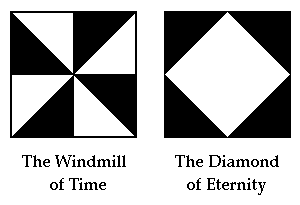

This image from “Black Narcissus”
casts Jean Simmons as Allure
and Deborah Kerr, in a pretty
contrast, as Eternity.
For different approaches to
these concepts, see Simmons
and Kerr in other films,
notably those co-starring
Burt Lancaster.
Lancaster seems to have had
a pretty good grasp of Allure
in his films with Simmons
and Kerr. For Eternity, see
“Rocket Gibraltar” and
“Field of Dreams.”
For less heterosexual approaches
to these concepts, see the
continuing culture coverage of
the Times— for instance, the
vampire essay above and the
Times‘s remarks Monday on
choreographer Merce Cunningham–
who always reminded me of
Carmen Ghia in “The Producers”–

Related material:
“Dance of the Vampires”
in “At the Still Point”
(this journal, 1/16/03).
Comments Off on Friday July 31, 2009
Friday, July 24, 2009
Comments Off on Friday July 24, 2009
Friday, July 10, 2009
Light History

Before the Screwing

“Very impressive, Herr Tesla,
but let’s not forget the
little man in the boat.”
Courtesy of Wired.com:
1895: Charles Proteus Steinmetz receives a patent for a “system of distribution by alternating currents.” His engineering work makes it practical to build a widespread power grid for use in lighting and machinery alike.
Comments Off on Friday July 10, 2009
Friday, July 3, 2009
Damnation Morning
continued
“The tigers of wrath are wiser
than the horses of instruction.”
— Blake
“… the moment is not
properly an atom of time
but an atom of eternity.
It is the first reflection
of eternity in time, its first
attempt, as it were, at
stopping time….”
— Kierkegaard
Todo lo sé por el lucero puro
que brilla en la diadema de la Muerte.
— Rubén Darío
Related material:
The deaths of
Ernest Hemingway
on the morning of
Sunday, July 2, 1961,
and of Alexis Arguello
on the morning of
Wednesday, July 1, 2009.
See also philosophy professor
Clancy Martin in the
London Review of Books
(issue dated July 9, 2009)
on AA members as losers—
“the ‘last men,’ the nihilists,
the hopeless ones.”
Comments Off on Friday July 3, 2009
Friday, June 26, 2009
Apocatastasis Now
I give you the end of a golden string,
Only wind it into a ball:
It will lead you in at Heavens gate,
Built in Jerusalems wall.
— WILLIAM BLAKE
"In 'Apocatastasis Now: A Very Condensed Reading of William Blake's Jerusalem' (JBSSJ [Journal of the Blake Society at St James's] 6 [2001] 18–25), Susanne Sklar argues that Blake is not apocalyptic but apocatastatic, that is (following a doctrine of Origen and Gregory of Nyssa) he believes that all free creatures will be redeemed by God's universal love."
— The Year's Work in English Studies, 2003: Vol. 82, No. 1, pp. 493-547
Related material:
From the website of Philip Pullman,
president of The Blake Society:
"I must create a System…"
The Blake Society, 25 October 2005: St James’s Church, Piccadilly
I see that the title of this lecture is given as BLAKE'S DARK MATERIALS. Now in the lecturer's handbook, the second rule says "You need take no obsessive notice of the title that has been announced in advance." Whether Blake's materials are dark or not I couldn't really say, but I am going to talk about Blake, partly, and partly about religion. Appropriate, perhaps, in a place like this, but you might think not appropriate from someone whose reputation is that of a scoffer or mocker or critic of religion; but I haven't come here to scoff or mock. Nor have I come here to recant, as a matter of fact. I'm profoundly interested in religion, and I think it's extremely important to understand it. I've been trying to understand it all my life, and every so often it's useful to put one's thoughts in order; but I shall never like God.
|
For more dark materials
from the Halloween season
of 2005 — in fact, from the
very date of Pullman's lecture–
see
Darkness Doubled.
Comments Off on Friday June 26, 2009
Friday, June 19, 2009
Comments Off on Friday June 19, 2009
Friday, June 12, 2009
|
New York Times Friday, June 12, 2009, 4:14 PM
By John Tierney
At the World Science Festival Thursday night [June 11, 2009], four physicists offered an answer to the question that has plagued philosophers and scientists: Why is there something rather than nothing at all?
|
Sure they did.
Two years ago:
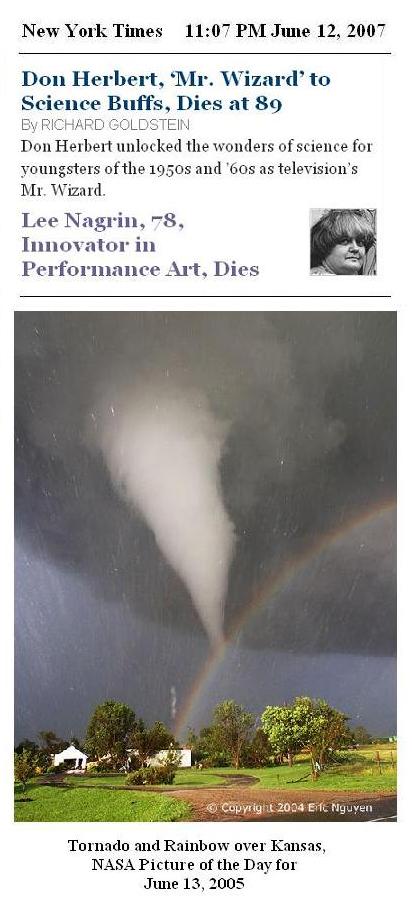
"A strange thing then happened." — L. Frank Baum
Related material:
Introduction to Abstract Classicism
Comments Off on Friday June 12, 2009
Friday, May 22, 2009
Steiner System
New York Times
banner this morning:

Click to enlarge.
Related material from
July 11, 2008:

|
The HSBC Logo Designer —
Henry Steiner
 He is an internationally recognized corporate identity consultant. Based in Hong Kong, his work for clients such as HongkongBank, IBM and Unilever is a major influence in Pacific Rim design. He is an internationally recognized corporate identity consultant. Based in Hong Kong, his work for clients such as HongkongBank, IBM and Unilever is a major influence in Pacific Rim design.
Born in Austria and raised in New York, Steiner was educated at Yale under Paul Rand and attended the Sorbonne as a Fulbright Fellow. He is a past President of Alliance Graphique Internationale. Other professional affiliations include the American Institute of Graphic Arts, Chartered Society of Designers, Design Austria, and the New York Art Directors' Club.
His Cross-Cultural Design: Communicating in the Global Marketplace was published by Thames and Hudson (1995).
— Yaneff.com
|
Charles Taylor,
"Epiphanies of Modernism,"
Chapter 24 of Sources of the Self
(Cambridge U. Press, 1989, p. 477):
"… the object sets up
a kind of frame or space or field
within which there can be epiphany."
|
Related material suggested by
an ad last night on
ABC's Ugly Betty season finale:


Diamond from last night's
Log24 entry, with
four colored pencils from
Diane Robertson Design:

See also
A Four-Color Theorem.
Comments Off on Friday May 22, 2009
Friday, May 15, 2009
Thanks to Jillian’s Specials for the following quotation:
“… faith is…. validated by individual experience and inspired by epiphanies.”
— “Where Physics Meets Faith,” by Robert C. Cowen, Oct. 21, 2004
Individual Experience:
See, for instance, the link in last Sunday’s entry to a remarkable group-theoretic map.
Epiphanies:
Part I: For Jillian —

(with a nod to Matthew McConaughey and his films Contact and, more recently, Ghosts of Girlfriends Past).
Part II: For a mountaineer–
In this morning’s news:

(with a nod to Tom Hanks and to Gian-Carlo Rota and the Black Hole of Rome (cf. Psychoshop) as well as to the mountains, both real and imagined, in last Sunday’s link “a remarkable group-theoretic map“).
Comments Off on Friday May 15, 2009
Friday, April 24, 2009
Dark Passage
“Anakin Skywalker, otherwise known
as Darth Vader, is arguably
the central character in
George Lucas’s ‘Star Wars’….“
— Amazon.com review
Ken Annakin, classic action
filmmaker, dies at 94 —
“Annakin’s last name
was the source
of the name for
Anakin Skywalker.”
— Entertainment Weekly
Dennis McLellan in today’s Los Angeles Times:
“Contrary to previous reports that George Lucas named the ‘Star Wars’ character Anakin Skywalker (Darth Vader) after Annakin, Lucas said via his publicist Thursday that he did not.”
Mike O’Sullivan, Voice of America LA bureau chief, in 2007:
“Annakin inadvertently gave his own name to a film character, although the spelling is slightly different, when the actor Alec Guinness suggested the name to director George Lucas for a character in the Star Wars films.
At a screening of the film, Annakin asked Lucas about it.
‘He was running his picture with Anakin Skywalker in it, and I went over to him and said, “you know, you never got permission for this.” He said, “but I dropped an ‘n’ and therefore I got away with it,”‘ Annakin said.”
This morning’s NY Times
obituaries include…
The British-born Annakin
(best known for war epics),
British cinematographer Jack Cardiff,
and Santha Rama Rau (author
of a 1960 play based on the
novel A Passage to India) —

Passage O soul to India!
Eclaircise the myths Asiatic,
the primitive fables.
Not you alone proud truths of the world,
Nor you alone ye facts of modern science,
But myths and fables of eld,
Asia’s, Africa’s fables,
The far-darting beams of the spirit,
the unloos’d dreams,
The deep diving bibles and legends….
— Walt Whitman
“Ready when you are, C. B.“
For Cardiff, cinematographer
of “A Matter of Life and Death“
and of “Black Narcissus” —
Happy Birthday
to a Dark Lady
Comments Off on Friday April 24, 2009
Friday, April 17, 2009
Begettings of
the Broken Bold
Thanks for the following
quotation (“Non deve…
nella testa“) go to the
weblog writer who signs
himself “Conrad H. Roth.”
|
… Yesterday I took leave of my Captain, with a promise of visiting him at Bologna on my return. He is a true
A PAPAL SOLDIER’S IDEAS OF PROTESTANTS 339
representative of the majority of his countrymen. Here, however, I would record a peculiarity which personally distinguished him. As I often sat quiet and lost in thought he once exclaimed “Che pensa? non deve mai pensar l’uomo, pensando s’invecchia;” which being interpreted is as much as to say, “What are you thinking about: a man ought never to think; thinking makes one old.” And now for another apophthegm of his; “Non deve fermarsi l’uomo in una sola cosa, perche allora divien matto; bisogna aver mille cose, una confusione nella testa;” in plain English, “A man ought not to rivet his thoughts exclusively on any one thing, otherwise he is sure to go mad; he ought to have in his head a thousand things, a regular medley.”
Certainly the good man could not know that the very thing that made me so thoughtful was my having my head mazed by a regular confusion of things, old and new. The following anecdote will serve to elucidate still more clearly the mental character of an Italian of this class. Having soon discovered that I was a Protestant, he observed after some circumlocution, that he hoped I would allow him to ask me a few questions, for he had heard such strange things about us Protestants that he wished to know for a certainty what to think of us.
|
Notes for Roth:

The title of this entry,
“Begettings of the Broken Bold,”
is from Wallace Stevens’s
“The Owl in the Sarcophagus”–
This was peace after death, the brother of sleep,
The inhuman brother so much like, so near,
Yet vested in a foreign absolute,
Adorned with cryptic stones and sliding shines,
An immaculate personage in nothingness,
With the whole spirit sparkling in its cloth,
Generations of the imagination piled
In the manner of its stitchings, of its thread,
In the weaving round the wonder of its need,
And the first flowers upon it, an alphabet
By which to spell out holy doom and end,
A bee for the remembering of happiness.
Peace stood with our last blood adorned, last mind,
Damasked in the originals of green,
A thousand begettings of the broken bold.
This is that figure stationed at our end,
Always, in brilliance, fatal, final, formed
Out of our lives to keep us in our death....
|
Related material:
Some further context:
Roth’s entry of Nov. 3, 2006–
“Why blog, sinners?“–
and Log24 on that date:
“First to Illuminate.”
Comments Off on Friday April 17, 2009
Friday, April 10, 2009
Pilate Goes
to Kindergarten
“There is a pleasantly discursive
treatment of Pontius Pilate’s
unanswered question
‘What is truth?’.”
— H. S. M. Coxeter, 1987,
introduction to Trudeau’s
remarks on the “Story Theory“
of truth as opposed to the
“Diamond Theory” of truth in
The Non-Euclidean Revolution
Consider the following question in a paper cited by V. S. Varadarajan:
E. G. Beltrametti, “Can a finite geometry describe physical space-time?” Universita degli studi di Perugia, Atti del convegno di geometria combinatoria e sue applicazioni, Perugia 1971, 57–62.
Simplifying:
“Can a finite geometry describe physical space?”
Simplifying further:
“Yes. Vide ‘The Eightfold Cube.'”
Comments Off on Friday April 10, 2009
Friday, April 3, 2009
“Philosophers ponder the idea of identity: what it is to give something a name on Monday and have it respond to that name on Friday….”
— Bernard Holland in The New York Times of Monday, May 20, 1996
Yesterday’s afternoon entry cited philosopher John Holbo on chess. This, together with Holland’s remark above and Monday’s entries on Zizek, suggests…
Holbo on Zizek(
pdf, 11 pages)
In this excellent analysis,
Holbo quotes Kierkegaard:
“… the knight of faith
‘has the pain of being unable to
make himself intelligible to others'”
(Kierkegaard, Fear and Trembling)
For some material that may serve to illustrate Kierkegaard’s remark, see Log24 on
Twelfth Night and
Epiphany this year.
“… There was a problem laid out on the board, a six-mover. I couldn’t solve it, like a lot of my problems. I reached down and moved a knight…. I looked down at the chessboard. The move with the knight was wrong. I put it back where I had moved it from. Knights had no meaning in this game. It wasn’t a game for knights.”
— Raymond Chandler, The Big Sleep
Context: the five entries
ending at 9:26 AM
on March 10, 2009…
and, for Kierkegaard,
Diamonds Are Forever.
Comments Off on Friday April 3, 2009
Friday, March 20, 2009
Happy Birthday,
Holly Hunter
Epigraph to
The Glass Bead Game:
Non entia enim licet quodammodo levibusque hominibus facilius atque incuriosius verbis reddere quam entia, veruntamen pio diligentique rerum scriptori plane aliter res se habet: nihil tantum repugnat ne verbis illustretur, at nihil adeo necesse est ante hominum oculos proponere ut certas quasdam res, quas esse neque demonstrari neque probari potest, quae contra eo ipso, quod pii diligentesque viri illas quasi ut entia tractant, enti nascendique facultati paululum appropinquant.
— ALBERTUS SECUNDUS
tract. de cristall. spirit.
ed. Clangor et Collof. lib. I, cap. 28.
In Joseph Knecht’s holograph translation:.
For although in a certain sense and for light-minded persons non-existent things can be more easily and irresponsibly represented in words than existing things, for the serious and conscientious historian it is just the reverse. Nothing is harder, yet nothing is more necessary, than to speak of certain things whose existence is neither demonstrable nor probable. The very fact that serious and conscientious men treat them as existing things brings them a step closer to existence and to the possibility of being born.

Comments Off on Friday March 20, 2009
Friday, March 13, 2009
Rat Psychology
Lawrence Summers, former president of Harvard, home of the rat psychology of Skinner and Quine, today offered a lesson in behavioral economics.
From a transcript of Summers’s remarks (for a video, see the previous entry)–
“An abundance of greed and an absence of fear on Wall Street led some to make purchases – not based on the real value of assets, but on the faith that there would be another who would pay more for those assets. At the same time, the government turned a blind eye to these practices and their potential consequences for the economy as a whole. This is how a bubble is born. And in these moments, greed begets greed. The bubble grows.
Eventually, however, this process stops – and reverses. Prices fall. People sell. Instead of an expectation of new buyers, there is an expectation of new sellers. Greed gives way to fear. And this fear begets fear.
This is the paradox at the heart of the financial crisis. In the past few years, we’ve seen too much greed and too little fear; too much spending and not enough saving; too much borrowing and not enough worrying. Today, however, our problem is exactly the opposite.
It is this transition from an excess of greed to an excess of fear that President Roosevelt had in mind when he famously observed that the only thing we had to fear was fear itself. It is this transition that has happened in the United States today.”
Related material

Spatial Practice,
Paris-Style:

“Voids, a Retrospective,”
an exhibit of empty rooms
that runs through March 23
at the Centre Pompidou
See also “Art Humor“
and “Conceptual Art.”
Comments Off on Friday March 13, 2009
Comments Off on Friday March 13, 2009
Radical Emptiness
Tom Conoboy on James Purdy’s novel Malcolm:
“Life, Purdy is telling us, is meaningless. Existence is absurd. It consists of events and happenings, all unavoidable, all simultaneously significant and meaningless. They touch you, wound even, ultimately kill, yet somehow existence appears to obtain in a bubble outside of the self. As Thomas M. Lorch describes it, ‘the novel portays humanity revolving about an abyss.'[1] What is real is not real, and what is not real becomes real. Malcolm describes himself as a ‘cypher’ and, in the end, his death affects no-one, least of all him.
Yet, through this, Purdy presents us with the final, and greatest, paradox. In presenting us with nothingness, and in deliberately describing the action in such bland and emotionless language, Purdy actually creates a sense of loss: there is nothing to lose, he is telling us, and yet we feel the loss greatly. What he does is to create a world of genuine nihilism, where nobody communicates, nobody connects, so that we can, in negative, imagine what a world in harmony might be like.”
[1] Thomas M. Lorch, “Purdy’s Malcolm: A Unique Vision of Radical Emptiness.” Wisconsin Studies in Contemporary Literature, Vol. 6, No. 2 (Summer, 1965), p. 212.
See you in the
funny papers, Purdy.

Comments Off on Friday March 13, 2009
Midnight in the Garden
From 12:00 AM on last month’s
Friday the 13th:

From the soundtrack CD of
“Midnight in the Garden
of Good and Evil”–
“Accentuate the positive.”
— Clint Eastwood
MODE online:
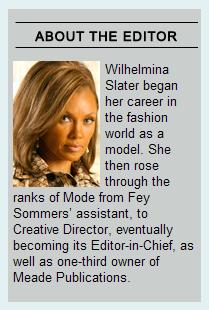 |
My advice for this month is to learn the lesson from the young and innocent. Embrace optimism and go forward with life, hoping only for the best…. Accentuate your positives and don’t worry about your negatives…. Because when you smile, others smile back.
Wilhelmina Slater |
Comments Off on Friday March 13, 2009
Friday, March 6, 2009
The Illuminati Stone
TV listing for this evening —
Family Channel, 7:30 PM:
"Harry Potter and
the Sorcerer's Stone"
In other entertainment news —
Scheduled to open May 15:

"Only gradually did I discover
what the mandala really is:
'Formation, Transformation,
Eternal Mind's eternal recreation'"
(Faust, Part Two)
— Carl Gustav Jung
Related material:
|
"For just about half a century, E.J. Holmyard's concisely-titled Alchemy has served as a literate, well-informed, and charming introduction to the history and literature of Western alchemy." —Ian Myles Slater
|

For more about this
"prime matter" (prima materia)
see The Diamond Archetype

and Holy the Firm.
Background:
Holmyard —

— and Aristotle's
On Generation and Corruption.
Comments Off on Friday March 6, 2009
Friday, February 27, 2009
Lasting Significance
Wittgenstein’s Lasting Significance, edited by Max Kölbel and Bernhard Weiss, published by Routledge, 2004–
Page 168:
“Wittgenstein told Norman Malcolm that ‘a serious and good philosophical work could be written that would consist entirely of jokes (without being facetious)’ (Malcolm 1999: 64).”
Malcolm, N. (1999) “Wittgenstein: A Memoir,” in F.A. Flowers (ed.) Portraits of Wittgenstein, vol. 3, Bristol: Thoemmes Press, pp. 60-112
The lasting significance here is perhaps in the page numbers.
Comments Off on Friday February 27, 2009
Friday, February 20, 2009
The Cross
of Constantine
mentioned in
this afternoon's entry
"Emblematizing the Modern"
was the object of a recent
cinematic chase sequence
(successful and inspiring)
starring Mira Sorvino
at the Metropolitan
Museum of Art.
In memory of
Dr. Hunter S. Thompson,
dead by his own hand
on this date
four years ago —

Click for details.
There is
another sort of object
we may associate with a
different museum and with
a modern Constantine …
See "Art Wars for MoMA"
(Dec. 14, 2008).
This object, modern
rather than medieval,
is the ninefold square:

It may suit those who,
like Rosalind Krauss
(see "Emblematizing"),
admire the grids of modern art
but view any sort of Christian
cross with fear and loathing.
For some background that
Dr. Thompson might appreciate,
see notes on Geometry and Death
in this journal, June 1-15, 2007,
and the five Log24 entries
ending at 9 AM Dec. 10. 2006,
which include this astute
observation by J. G. Ballard:
"Modernism's attempt to build a better world with the aid of science and technology now seems almost heroic. Bertolt Brecht, no fan of modernism, remarked that the mud, blood and carnage of the first world war trenches left its survivors longing for a future that resembled a white-tiled bathroom."
Selah.
Comments Off on Friday February 20, 2009
Comments Off on Friday February 20, 2009
Note that in applications, the vertical axis
of the Cross of Descartes often symbolizes
the timeless (money, temperature, etc.)
while the horizontal axis often symbolizes time.
T.S. Eliot:
"Men’s curiosity searches past and future
And clings to that dimension. But to apprehend
The point of intersection of the timeless
With time, is an occupation for the saint…."
|
There is a reason, apart from her
ethnic origins, that Rosalind Krauss (cf.
9/13/06) rejects, with a shudder, the cross as a key to "the Pandora's box of spiritual reference that is opened once one uses it." The rejection occurs in the context of her attempt to establish not the cross, but the
grid, as a religious symbol:
|
"In suggesting that the success [1] of the grid
is somehow connected to its structure as myth,
I may of course be accused of stretching a point
beyond the limits of common sense, since myths
are stories, and like all narratives they unravel
through time, whereas grids are not only spatial
to start with, they are visual structures
that explicitly reject a narrative
or sequential reading of any kind.
[1] Success here refers to
three things at once:
a sheerly quantitative success,
involving the number of artists
in this century who have used grids;
a qualitative success through which
the grid has become the medium
for some of the greatest works
of modernism; and an ideological
success, in that the grid is able–
in a work of whatever quality–
to emblematize the Modern."
— Rosalind Krauss, "Grids" (1979)
|
Related material:
Time Fold and Weyl on
objectivity and frames of reference.
See also Stambaugh on
The Formless Self
as well as
A Study in Art Education
and
Jung and the Imago Dei.
Comments Off on Friday February 20, 2009
Friday, February 13, 2009
Fire and Ice 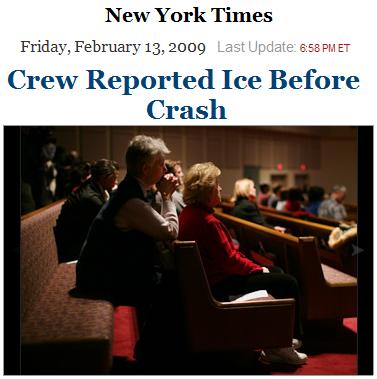
Prologue from
Answers.com:
bombardier
The member of a
combat aircraft crew who
operates the bombsight
and drops the bombs.
|
February 13, 2009 — Toronto
Press Release
Bombardier confirms a Dash 8 Q400 aircraft was involved in an accident near Buffalo, New York on February 12. We extend our sympathies to the families of those who perished in this accident. Bombardier has dispatched a product safety and technical team to the site to assist the National Transportation Safety Board with their investigation.
Until such time as the investigators release any information or findings, Bombardier cannot comment further or speculate on the cause of this accident.
Bombardier Q400 product information is available on www.q400.com.
|
Comments Off on Friday February 13, 2009
DENNIS OVERBYE
“From the grave, Albert Einstein poured gasoline on the culture wars between science and religion this week.
A letter the physicist wrote in 1954 to the philosopher Eric Gutkind, in which he described the Bible as ‘pretty childish’….”
This morning’s
New York Times:
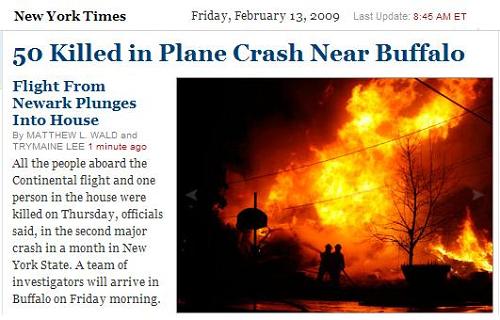
The plane crashed at about 10:20 PM.
Meanwhile…
Yesterday evening in Springfield (as scheduled):
6:20 PM THE PRESIDENT arrives in Springfield, IL
7:00 PM THE PRESIDENT delivers remarks at the 102nd Abraham Lincoln Association Annual Banquet
8:30 PM THE PRESIDENT departs from Springfield, IL
Religious summary by
Buffalo Springfield:
“Stop, children,
what’s that sound?
Everybody look
what’s going down.” |
Comments Off on Friday February 13, 2009
Happy birthday to
King Friday XIII
and friend:

Yesterday, by the way,
was Georgia Day
in Savannah.

“I Put a Spell on You”
— Nina Simone,
title of autobiograpy
“The voodoo priestess looked across the table at her wealthy client, a man on trial for murder: ‘Now, you know how dead time works. Dead time lasts for one hour– from half an hour before midnight to half an hour after midnight. The half-hour before midnight is for doin’ good. The half-hour after midnight is for doin’ evil….'”
— Glenna Whitley, “Voodoo Justice,” The New York Times, March 20, 1994
Comments Off on Friday February 13, 2009
Friday, February 6, 2009
Eternal City
Today’s New York Times:
“Olga Raggio was born in Rome on Feb. 5, 1926, to a Russian mother and an Italian father. She earned a diploma from the Vatican library school in 1947 and a Ph.D. from the University of Rome in 1949.”
“… Raggio, an internationally known scholar and curator who in almost 60 years with the Metropolitan Museum of Art organized some of its best-known exhibitions, scoured the world for treasure and coaxed rarely seen artworks from places as far flung as the Vatican and as close at hand as a New Jersey abbey, died on Jan. 24 in the Bronx. She was 82 and lived in Manhattan.”
Quoted here on the date of Raggio’s death:
“Death is not earnest in the same way the eternal is. To the earnestness of death belongs precisely that capacity for awakening, that resonance of a profound mockery which, detached from the thought of the eternal, is an empty and often brash jest, but together with the thought of the eternal is just what it should be, utterly different from the insipid solemness which least of all captures and holds a thought with tension like that of death.”
— Soren Kierkegaard, Works of Love, Harper Torchbooks, 1964, p. 324
Related material:
February 2, 3, and 4 as well as
February 5 (Raggio’s birthday).
Comments Off on Friday February 6, 2009
Friday, January 30, 2009
Two-Part Invention
This journal on
October 8, 2008,
at noon:
“There is a pleasantly discursive treatment of Pontius Pilate’s unanswered question ‘What is truth?'”
— H. S. M. Coxeter, introduction to Richard J. Trudeau’s remarks on the “story theory” of truth as opposed to the “diamond theory” of truth in The Non-Euclidean Revolution
Trudeau’s 1987 book uses the phrase “diamond theory” to denote the philosophical theory, common since Plato and Euclid, that there exist truths (which Trudeau calls “diamonds”) that are certain and eternal– for instance, the truth in Euclidean geometry that the sum of a triangle’s angles is 180 degrees.
Insidehighered.com on
the same day, October 8, 2008,
at 12:45 PM EDT
“Future readers may consider Updike our era’s Mozart; Mozart was once written off as a too-prolific composer of ‘charming nothings,’ and some speak of Updike that way.”
— Comment by BPJ |
“Birthday, death-day–
what day is not both?”
—
John Updike
Updike died on January 27.
On the same date,
Mozart was born.
Requiem
Mr. Best entered,
tall, young, mild, light.
He bore in his hand
with grace a notebook,
new, large, clean, bright.
— James Joyce, Ulysses,
Shakespeare and Company,
Paris, 1922, page 178 |
Related material:
Comments Off on Friday January 30, 2009
Friday, January 23, 2009
“Numb were the Beadsman’s fingers,
while he told |
|
His rosary, and while
his frosted breath, |
|
Like pious incense
from a censer old, |
|
Seem’d taking flight for heaven,
without a death….”
— John Keats |
“The word not only brings the things out of silence; it also produces the silence in which they can disappear again.”
— Max Picard, The World of Silence,
quoted here on January 15
“Let the word go forth….”
— John Fitzgerald Kennedy, quoted here
on January 20 — The Eve of St. Agnes
Related material:
Fish contrasts President Obama’s prose style with one that “asks the reader or hearer to hold in suspension the components of an argument that will not fully emerge until the final word.”
See also the final word of this journal’s entry on January 21, which was “Keats.”
Comments Off on Friday January 23, 2009
Friday, January 16, 2009
Behind
the Picture
“Oftentimes people will like a picture I paint because it’s maybe the sun hitting on the side of a window and they can enjoy it purely for itself,” Wyeth once said. “It reminds them of some afternoon. But for me, behind that picture could be a night of moonlight when I’ve been in some house in Maine, a night of some terrible tension, or I had this strange mood. Maybe it was Halloween. It’s all there, hiding behind the realistic side.”
— Andrew Wyeth, who died today
Related material:
“In the pictures of the old masters, Max Picard wrote in The World of Silence, people seem as though they had just come out of the opening in a wall… ”
— Annie Dillard in For the Time Being
“And the wall is made of light– that entirely credible yet unreal Vermeer light. Light like this does not exist, but we wish it did.”
— Susanna Kaysen in Girl, Interrupted
Comments Off on Friday January 16, 2009
Academy Award
“Philosophers ponder the idea of identity: what it is to give something a name on Monday and have it respond to that name on Friday.”
— Bernard Holland
“I feel very happy to be a part of Mind Champions Academy.”
— A winner at a chess awards ceremony in India on Monday
John Mortimer, who wrote the TV version of Brideshead Revisited, died today. In his memory:
Comments Off on Friday January 16, 2009
Friday, January 9, 2009
Stories
for Mary Karr
"In reality, my prose books
probably sit between
I Was a Teenage Sex Slave
and some other contemporary
memoir written in five minutes…."
— Mary Karr in the NY Times
of July 6, 2007

See also
Ballet Blanc
and the true story
0, 1, 2, 3, ….
"In a dream scenario, my memoirs…
would find another shelf.
They’d sit between St. Augustine
and Nabokov’s Speak, Memory…."
— Mary Karr, loc. cit.
Recall the
mnemonic rhyme
"Nine is a Vine."
Comments Off on Friday January 9, 2009
Teaser head from the
online NY Times
this morning:
Comments Off on Friday January 9, 2009
Friday, January 2, 2009
Signs and Symbols
continued…
from the five entries
ending on June 3, 2008
and from yesterday,
New Year's Day
The end of
a story by Vladimir Nabokov in
The New Yorker of May 15, 1948:
"You have the incorrect number. I will tell you what you are doing: you are turning the letter O instead of the zero."
They sat down to their unexpected festive midnight tea. The birthday present stood on the table. He sipped noisily; his face was flushed; every now and then he imparted a circular motion to his raised glass so as to make the sugar dissolve more thoroughly. The vein on the side of his bald head where there was a large birthmark stood out conspicuously and, although he had shaved that morning, a silvery bristle showed on his chin. While she poured him another glass of tea, he put on his spectacles and re-examined with pleasure the luminous yellow, green, red little jars. His clumsy moist lips spelled out their eloquent labels: apricot, grape, beech plum, quince. He had got to crab apple, when the telephone rang again.
Click for details.
Comments Off on Friday January 2, 2009
Friday, December 26, 2008
Narrative
“Wayne C. Booth’s lifelong
study of the art of rhetoric
illuminated the means
by which authors seduce,
cajole and lie to their readers
in the service of narrative.”
— New York Times, Oct. 11, 2005
Roberta Smith in a
New York Times Christmas Day review of an exhibit at the Museum of Modern Art:
“He ends the show with Ed Ruscha’s painting ‘The End.’ But if you consult the brochure, you’ll see that it also lists one final object up above, near the ceiling. This is the green LED exit sign that directs you out of the gallery. The sign, designed by Mark Wamble, Dawn Finley and Ben Thorne of Interloop Architecture, is, like everything else here, in the Modern’s collection. Here, of course, it is also just doing its job.”
Other Christmas Day endings —
Those of W.C. Fields– see Cafe Society (April 14, 2007)– and, this year, of Eartha Kitt:

From April 12 last year:

This Way to
the Egress
Comments Off on Friday December 26, 2008
Friday, December 19, 2008
Inside the
White Cube
Part I: The White Cube

Part II: Inside

Part III: Outside

Click to enlarge.
Mark Tansey, The Key (1984)
For remarks on religion
related to the above, see
Log24 on the Garden of Eden
and also Mark C. Taylor,
"What Derrida Really Meant"
(New York Times, Oct. 14, 2004).
For some background on Taylor,
see Wikipedia. Taylor, Chairman
of the Department of Religion at
Columbia University, has a
1973 doctorate in religion from
Harvard University. His opinion
of Derrida indicates that his
sympathies lie more with
the serpent than with the angel
in the Tansey picture above.
For some remarks by Taylor on
the art of Tansey relevant to the
structure of the white cube
(Part I above), see Taylor's
The Picture in Question:
Mark Tansey and the
Ends of Representation
(U. of Chicago Press, 1999):
From Chapter 3,
"Sutures* of Structures," p. 58:
"What, then, is a frame, and what is frame work?
This question is deceptive in its simplicity. A frame is, of course, 'a basic skeletal structure designed to give shape or support' (American Heritage Dictionary)…. when the frame is in question, it is difficult to determine what is inside and what is outside. Rather than being on one side or the other, the frame is neither inside nor outside. Where, then, Derrida queries, 'does the frame take place….'"
* P. 61:
"… the frame forms the suture of structure. A suture is 'a seamless [sic**] joint or line of articulation,' which, while joining two surfaces, leaves the trace of their separation."
** A dictionary says "a seamlike joint or line of articulation," with no mention of "trace," a term from Derrida's jargon.
|
Comments Off on Friday December 19, 2008
Friday, December 12, 2008
On the Symmetric Group S8
Wikipedia on Rubik's 2×2×2 "Pocket Cube"–
"Any permutation of the 8 corner cubies is possible (8! positions)."
Some pages related to this claim–
Simple Groups at Play
Analyzing Rubik's Cube with GAP
Online JavaScript Pocket Cube.
The claim is of course trivially true for the unconnected subcubes of Froebel's Third Gift:

 © 2005 The Institute for Figuring
© 2005 The Institute for Figuring
Comments Off on Friday December 12, 2008
“Somehow it seems to fill my head with ideas– only I don’t exactly know what they are!…. Let’s have a look at the garden first!”
— A passage from Lewis Carroll’s Through the Looking-Glass. The “garden” part– but not the “ideas” part– was quoted by Jacques Derrida in Dissemination in the epigraph to Chapter 7, “The Time before First.”
“‘For you… he… we aren’t meaning…’ She was almost stammering, as if she were trying to say several things at once…. Suddenly she gave a little tortured scream. ‘O!’ she cried, ‘O! I can’t keep up! it keeps dividing! There’s too many things to think of!'”
— A passage from Charles Williams’s The Place of the Lion, Chapter 12.
“He was thinking faster than he had ever done, and questions rose out of nothing and followed each other– what was to will? Will was determination to choose– what was choice? How could there be choice, unless there was preference, and if there was preference there was no choice, for it was not possible to choose against that preferring nature which was his being; yet being consisted in choice, for only by taking and doing this and not that could being know itself, could it indeed be; to be then consisted in making an inevitable choice, and all that was left was to know the choice, yet even then was the chosen thing the same as the nature that chose, and if not… So swiftly the questions followed each other that he seemed to be standing in flashing coils of subtlety, an infinite ring of vivid intellect and more than intellect, for these questions were not of the mind alone but absorbed into themselves physical passion and twined through all his nature on an unceasing and serpentine journey.”
— A passage from The Place of the Lion, Chapter 10.
“Do you like apples?“
— Good Will Hunting
Comments Off on Friday December 12, 2008
Friday, December 5, 2008
Continued from
Monday:
A Version of
Heaven’s Gate
in memory of
Alexy II, the Russian Orthodox
patriarch who died today in Moscow:

The Pearly Gates of Cyberspace:
From Geoffrey Broadbent,
“Why a Black Square?” in Malevich
(London, Art and Design/
Academy Group, 1989, p. 49):
“Malevich’s Black Square seems to be
nothing more, nor less, than his
‘Non-Objective’ representation
of Bragdon’s (human-being-as) Cube
passing through the ‘Plane of Reality.’!”
Comments Off on Friday December 5, 2008
Friday, November 14, 2008
Ballistics and Faith
From a review of José Saramago‘s new novel, Death With Interruptions:
“The church has never been asked to explain anything,” the cardinal assures the prime minister. “Our specialty, along with ballistics, has always been the neutralization of the overly curious mind through faith.”
Related material:
Sept. 7, 2006- Birthday of Elizabeth I
Sept. 7, 2007- Madeleine L’Engle is Dead
Sept. 7, 2008- From the Finland Station
For some mythology relevant to the first two of these three dates, see “Damnation Morning” and The Big Time. For some non-mythology related to ballistics, faith, and the third of these dates, see Rudy Ratzinger vs. Joseph Ratzinger.
As for the main character
of Saramago’s novel…
“V. is whatever lights you to
the end of the street:
she is also the dark annihilation
waiting at the end of the street.”
— Tony Tanner, page 36,
“V. and V-2,” in
Pynchon: A Collection
of Critical Essays.
Ed. Edward Mendelson.
Englewood Cliffs, N. J.:
Prentice-Hall, 1978. 16-55.
|
Comments Off on Friday November 14, 2008
Friday, November 7, 2008
The Sincerest Form
of Flattery
At a British puzzle website today I found this, titled “Tiles Puzzle by Steven H. Cullinane”–

The version there states that
“there are 322,560 patterns made by swapping rows, swapping columns and swapping the four 2×2 quadrants!”
Comments Off on Friday November 7, 2008
Friday, October 24, 2008
“The Cube Space” is a name given to the eightfold cube in a vulgarized mathematics text, Discrete Mathematics: Elementary and Beyond, by Laszlo Lovasz et al., published by Springer in 2003. The identification in a natural way of the eight points of the linear 3-space over the 2-element field GF(2) with the eight vertices of a cube is an elementary and rather obvious construction, doubtless found in a number of discussions of discrete mathematics. But the less-obvious generation of the affine group AGL(3,2) of order 1344 by permutations of parallel edges in such a cube may (or may not) have originated with me. For descriptions of this process I wrote in 1984, see Diamonds and Whirls and Binary Coordinate Systems. For a vulgarized description of this process by Lovasz, without any acknowledgement of his sources, see an excerpt from his book.
Comments Off on Friday October 24, 2008
Friday, October 17, 2008
“Every musician wants to do something of lasting quality, something which will hold up for a long time, and I guess we did it with ‘Stairway.'”
— Jimmy Page on “Stairway to Heaven“
Comments Off on Friday October 17, 2008
Friday, October 10, 2008
The Fury
Comes Later
Maureen Dowd’s New York Times column, “Sound, but No Fury,” on the September 26 debate at Oxford, Mississippi–
“Who would have dreamed that when socialism finally came to the U.S.A. it would be brought not by Bolsheviks in blue jeans but Wall Street bankers….?”
Perhaps Ernest Lehman, author of screenplays for “The Prize” and “From the Terrace.” (See recent Log24 entries.)
Paul Krugman’s column in today’s online Times, “Moment of Truth“–
“The consequences of Lehman’s fall were apparent within days, yet key policy players have largely wasted the past four weeks. Now they’ve reached a moment of truth: They’d better do something soon– in fact, they’d better announce a coordinated rescue plan this weekend– or the world economy may well experience its worst slump since the Great Depression.
Let’s talk about where we are right now.”
Song of Songs 8:8–We have a little sister,and she hath no breasts:what shall we do for our sisterin the day when she shallbe spoken for?
“In Lehman’s fall
We sinned all.”
Comments Off on Friday October 10, 2008
Friday, October 3, 2008
The Prize

“The secret to life, and
to love, is getting started,
keeping going, and then
getting started again.”
Nobel Laureate
Seamus Heaney
at Sanders Theatre,
Harvard College,
September 30, 2008
On Elke Sommer:
“…Young Elke… studied
in the prestigious
Gymnasium School
in Erlangen….”
— Film Fatales
Erlangen Prize Lecture:
Variations on a Theme of
Plato, Goethe, and Klein
(Background:
Christmas Knot, Sept. 26,
and Hard Core, July 17-18.)
Friday, September 26, 2008
Christmas Knotfor T.S. Eliot’s birthday
(Continued from Sept. 22–
“A Rose for Ecclesiastes.”)
From Kibler’s
“Variations on a Theme of
Heisenberg, Pauli, and Weyl,”
July 17, 2008:
“It is to be emphasized
that the 15 operators…
are underlaid by the geometry
of the generalized quadrangle
of order 2…. In this geometry,
the five sets… correspond to
a spread of this quadrangle,
i.e., to a set of 5 pairwise
skew lines….”
— Maurice R. Kibler,
July 17, 2008
For ways to visualize
this quadrangle,

see Inscapes.
|
Related material
A remark of Heisenberg
quoted here on Christmas 2005:

“… die Schönheit… [ist] die
richtige Übereinstimmung
der Teile miteinander
und mit dem Ganzen.”
“Beauty is the proper conformity
of the parts to one another
and to the whole.”
|
Comments Off on Friday September 26, 2008
Friday, September 19, 2008
Comments Off on Friday September 19, 2008
Friday, September 5, 2008
For Mike Hammer
Block That Metaphor
“Michael Hammer, an engineer and author on management who helped popularize the ‘re-engineering’ movement in the 1990s, died Thursday [Sept. 4, 2008].
A spokesman for Mr. Hammer’s consulting firm, Hammer and Co., said Mr. Hammer died from cranial bleeding that began Aug. 22 while he was vacationing in Massachusetts. He was 60 years old.
Mr. Hammer was the co-author of the bestselling management book Reengineering the Corporation and founder and president of Hammer and Co., Cambridge, Mass.”
— The Wall Street Journal
“An engineer by training, Hammer focused on the operational nuts and bolts of business.
Hammer’s relentless pursuit of ‘why?’ drove his entire career. ‘My modus operandi is simple,’ he once wrote, ‘though not always easy to carry out. I take nothing at face value. I approach all business issues and practices with the same skepticism: Why?’
A funeral will be held at 9:30 a.m. Friday, Sept. 5 in Stanetsky Memorial Chapel, 1668 Beacon St., Brookline. Interment will follow at the Shaarei Tefillah Section of the Chevra Shaas Cemetery at Baker Street Jewish Cemeteries in West Roxbury.”
— web.mit.edu
Related material:
From Feb. 12:

From today:
Outside the Box

“I need a photo opportunity,
I want a shot at redemption.
Don’t want to end up a cartoon
In a cartoon graveyard…”
— Paul Simon

Comments Off on Friday September 5, 2008
Friday, August 22, 2008
Tentative movie title:
Blockheads

The Kohs Block Design
Intelligence Test
Samuel Calmin Kohs, the designer (but not the originator) of the above intelligence test, would likely disapprove of the "Aryan Youth types" mentioned in passing by a film reviewer in today's New York Times. (See below.) The Aryan Youth would also likely disapprove of Dr. Kohs.

Other related material:
1. Wechsler Cubes (intelligence testing cubes derived from the Kohs cubes shown above). See…
Harvard psychiatry and…
The Montessori Method;
The Crimson Passion;
The Lottery Covenant.
2. Wechsler Cubes of a different sort (Log24, May 25, 2008)
3. Manohla Dargis in today's New York Times:
"… 'Momma’s Man' is a touchingly true film, part weepie, part comedy, about the agonies of navigating that slippery slope called adulthood. It was written and directed by Azazel Jacobs, a native New Yorker who has set his modestly scaled movie with a heart the size of the Ritz in the same downtown warren where he was raised. Being a child of the avant-garde as well as an A student, he cast his parents, the filmmaker Ken Jacobs and the artist Flo Jacobs, as the puzzled progenitors of his centerpiece, a wayward son of bohemia….
In American movies, growing up tends to be a job for either Aryan Youth types or the oddballs and outsiders…."
4. The bohemian who named his son
Azazel:
"… I think that the deeper opportunity, the greater opportunity film can offer us is as an exercise of the mind. But an exercise, I hate to use the word, I won't say 'soul,' I won't say 'soul' and I won't say 'spirit,' but that it can really put our deepest psychological existence through stuff. It can be a powerful exercise. It can make us think, but I don't mean think about this and think about that. The very, very process of powerful thinking, in a way that it can afford, is I think very, very valuable. I basically think that the mind is not complete yet, that we are working on creating the mind. Okay. And that the higher function of art for me is its contribution to the making of mind."
— Interview with Ken Jacobs, UC Berkeley, October 1999
5. For Dargis's "Aryan Youth types"–
Comments Off on Friday August 22, 2008
Friday, August 8, 2008

Click on image for details.
Comments Off on Friday August 8, 2008
Friday, August 1, 2008
(From this weblog’s footprints today)
Comments Off on Friday August 1, 2008

Click on image for context.
Time of entry: 2:56:04 AM.
Comments Off on Friday August 1, 2008
Friday, July 25, 2008
56 Triangles

"This wonderful picture was drawn by Greg Egan with the help of ideas from Mike Stay and Gerard Westendorp. It's probably the best way for a nonmathematician to appreciate the symmetry of Klein's quartic. It's a 3-holed torus, but drawn in a way that emphasizes the tetrahedral symmetry lurking in this surface! You can see there are 56 triangles: 2 for each of the tetrahedron's 4 corners, and 8 for each of its 6 edges."
Exercise:
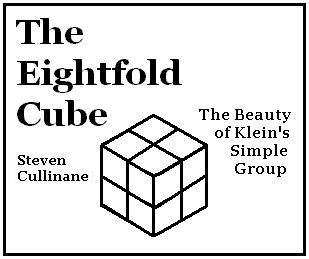
Click on image for further details.
Note that if eight points are arranged
in a cube (like the centers of the
eight subcubes in the figure above),
there are 56 triangles formed by
the 8 points taken 3 at a time.
Baez's discussion says that the Klein quartic's 56 triangles can be partitioned into 7 eight-triangle Egan "cubes" that correspond to the 7 points of the Fano plane in such a way that automorphisms of the Klein quartic correspond to automorphisms of the Fano plane. Show that the 56 triangles within the eightfold cube can also be partitioned into 7 eight-triangle sets that correspond to the 7 points of the Fano plane in such a way that (affine) transformations of the eightfold cube induce (projective) automorphisms of the Fano plane.
Comments Off on Friday July 25, 2008
Friday, July 11, 2008
Comments Off on Friday July 11, 2008
"I say high, you say low,
you say why,
and I say I don't know.
Oh, no.
You say goodbye
and I say hello."
— Hello Goodbye *
Thanks to NBC Nightly News tonight for a story on the following:
Manhattanhenge is an evening when "the Sun sets in exact alignment with the Manhattan grid, fully illuminating every single cross-street…."
Full Sun on grid:
Friday, July 11–
8:24 PM EDT
Related material from the late
Tom Disch on St. Sarah's Day:
Saturday, May 24th, 2008
9:15 pm
What I Can See from Here
I face east toward the western wall
Of a tall many-windowed building
Some distance off. I don't see the sunset
Directly, only as it is reflected
From the facade of that building.
Those familiar with Manhattan know
How the evening sun appears to slide
Into the slot of any east/west street,
And so its beams are channeled
Along those canyon streets to strike
Large objects like that wall
And scrawl their anti-shadows there,
A Tau of twilight luminescence
At close of day. I've seen this
For some forty years and only tonight
Did I realize what I had been looking at:
The way god tries to say good-bye.
— Tom Disch
|
* Walter Everett, in The Beatles as Musicians , has a note on the song "Hello Goodbye"–
"189. The extra-long coda… was referred to as the 'Maori finale' from the start…."
(Updated Feb. 27, 2013, to replace an incorrect reference in the footnote
to a book by Stanley Cavell instead of the correct book, by Walter Everett.)
Comments Off on Friday July 11, 2008
AND MORE LOGOS:
"Serious numbers will
always be heard."
— Paul Simon



|
The HSBC Logo Designer —
Henry Steiner
 He is an internationally recognized corporate identity consultant. Based in Hong Kong, his work for clients such as HongkongBank, IBM and Unilever is a major influence in Pacific Rim design. He is an internationally recognized corporate identity consultant. Based in Hong Kong, his work for clients such as HongkongBank, IBM and Unilever is a major influence in Pacific Rim design.
Born in Austria and raised in New York, Steiner was educated at Yale under Paul Rand and attended the Sorbonne as a Fulbright Fellow. He is a past President of Alliance Graphique Internationale. Other professional affiliations include the American Institute of Graphic Arts, Chartered Society of Designers, Design Austria, and the New York Art Directors' Club.
His Cross-Cultural Design: Communicating in the Global Marketplace was published by Thames and Hudson (1995).
— Yaneff.com
|
Related material
from the past —

Fly from Fly Bottle:

Charles Taylor,
"Epiphanies of Modernism,"
Chapter 24 of Sources of the Self
(Cambridge U. Press, 1989, p. 477) —
"… the object sets up
a kind of frame or space or field
within which there can be epiphany."
|
Related material
from today —
Escape from a
cartoon graveyard:

Comments Off on Friday July 11, 2008
LOGOS
"Religions are hardy."
— TIME magazine,
issue dated July 14
"I confess I do not believe in time."
— Vladimir Nabokov
"I can hardly do better than
go back to the Greeks."
— G. H. Hardy

Figure 1:
The Greeks

Figure 2:
The Irrational

Comments Off on Friday July 11, 2008
Friday, July 4, 2008
In memory of
Senator Jesse Helms, R-NC:
“I’m a church beside the highway
where the ditches never drain,
I’m a Baptist like my daddy,
and Jesus knows my name.”
— Mary Chapin Carpenter
Comments Off on Friday July 4, 2008
Comments Off on Friday July 4, 2008
Friday, June 27, 2008
Comments Off on Friday June 27, 2008
Comments Off on Friday June 27, 2008
Friday, June 20, 2008
Drunkard's Walk
In the above screenshot of New York Times obituaries on the date of Brewster Beach's death, Tim Russert seems to be looking at the obituary of Air Force Academy chapel architect Walter Netsch. This suggests another chapel, more closely related to my own experience, in Cuernavaca, Mexico. Some background… Walter Netsch in Oral History (pdf, 467 pp.):
"I also had a book that inspired me– this is 1947– called Communitas by Percival and Paul Goodman. Percival Goodman was the architect, and Paul Goodman was the writer and leftist. And this came out of the University of Chicago– part of the leftist bit of the University of Chicago…. I had sort of in the back of my mind, Communitas appeared from my subconscious of the new town out of town, and there were other people who knew of it…."
Log24, Feb. 24, 2008:

Chapel, Cuernavaca, Mexico
"God As Trauma" by Brewster Yale Beach:
"The problem of crucifixion is the beginning of individuation."
"Si me de veras quieres, deja me en paz."
— Lucero Hernandez, Cuernavaca, 1962
A more impersonal approach to my own drunkard's walk (Cuernavaca, 1962,
after reading the above words): Cognitive Blending and the Two Cultures
An approach from the culture (more precisely, the alternate religion) of Scientism–
The Drunkard's Walk: How Randomness Rules Our Lives— is sketched
in Today's Sermon: The Holy Trinity vs. The New York Times (Sunday, June 8, 2008).
The Times illustrated its review of The Drunkard's Walk with facetious drawings
by Jessica Hagy, who uses Venn diagrams to make cynical jokes.
A less cynical use of a Venn diagram:
"
No se puede vivir sin amar."

(March 3, 2004)
Comments Off on Friday June 20, 2008
Friday, June 13, 2008
A Real Book
Edward Rothstein last Monday:
"What is being said?
What does it mean?
Where does it come from
and where else is it used?"
A partial answer:
today's previous entry,
"For Philip Rieff,"
and an midrash on
the word "Pahuk"
(as in "Pahuk Pride,"
the name of this week's
Boy Scout gathering
in Iowa at which
a tornado killed four) —

Click on image for further details.
Rieff was the author of
Sacred Order/Social Order,
Volume 1–
My Life among the Deathworks:
Illustrations of the
Aesthetics of Authority
(University of Virginia Press, 2006)
Rieff's concept of sacred order
was Jewish rather than Pawnee,
but his writings still seem relevant.
Comments Off on Friday June 13, 2008
Comments Off on Friday June 13, 2008
Friday, June 6, 2008
Order and Disorder

Midrash:
The Dance of Chance
Associated Press
"Today in History"
Thought for Today:
"Two dangers constantly threaten
the world: order and disorder."
— Paul Valery, French poet
(1871-1945).
[La Crise de l'Esprit]
Also from Valéry:
«Notre esprit est fait d'un désordre,
plus un besoin de mettre en ordre.»
(Mauvaises Pensées et Autres)
«L’ordre pèse toujours à l’individu. Le désordre lui fait désirer la police ou la mort. Ce sont deux circonstances extrêmes où la nature humaine n’est pas à l’aise. L’individu recherche une époque tout agréable, où il soit le plus libre et le plus aidé. Il la trouve vers le commencement de la fin d’un système social. Alors, entre l’ordre et le désordre, règne un moment délicieux. Tout le bien possible que procure l’arrangement des pouvoirs et des devoirs étant acquis, c’est maintenant que l’on peut jouir des premiers relâchements de ce système. Les institutions tiennent encore. Elles sont grandes et imposantes. Mais sans que rien de visible soit altéré en elles, elles n’ont guère plus que cette belle présence; leurs vertus se sont toutes produites; leur avenir est secrètement épuisé; leur caractère n’est plus sacré, ou bien il n’est plus que sacré; la critique et le mépris les exténuent et les vident de toute valeur prochaine. Le corps social perd doucement son lendemain. C’est l’heure de la jouissance et de la consommation générale.»
— Paul Valéry, Préface aux Lettres Persanes (1926), recueillie dans Variété, II, 1930
Comments Off on Friday June 6, 2008
The Dance of Chance
"Harvard seniors have
every right to demand a
Harvard-calibre speaker."
— Adam Goldenberg in
The Harvard Crimson
"Look down now, Cotton Mather"
— Wallace Stevens,
Harvard College
Class of 1901
For Thursday, June 5, 2008,
commencement day for Harvard's
Class of 2008, here are the
Pennsylvania Lottery numbers:
Mid-day 025
Evening 761
Thanks to the late
Harvard professor
Willard Van Orman Quine,
the mid-day number 025
suggests the name
"Isaac Newton."
(For the logic of this suggestion,
see On Linguistic Creation
and Raiders of the Lost Matrix.)
Thanks to Google search, the
name of Newton, combined with
Thursday's evening number 761,
suggests the following essay:
|
Daniel E. Koshland Jr.*
* D. E. Koshland Jr. passed away on 23 July 2007. He was a professor of biochemistry and molecular and cell biology at the University of California, Berkeley, since 1965. He served as Science's editor-in-chief from 1985 to 1995.
|
Comments Off on Friday June 6, 2008
Friday, May 23, 2008
Happy St. Sarah‘s Day
(May 24)
“…something I once heard
Charles M. Schulz say,
‘Don’t worry about the world
coming to an end today.
It’s already tomorrow
in Australia.'”
— William F. House,
quoted here on Australia’s
St. Bridget’s Day, 2003

Click on image to view video.
Comments Off on Friday May 23, 2008
Comments Off on Friday May 23, 2008
Friday, May 16, 2008
“From the grave, Albert Einstein poured gasoline on the culture wars between science and religion this week.
A letter the physicist wrote in 1954 to the philosopher Eric Gutkind, in which he described the Bible as ‘pretty childish’ and scoffed at the notion that the Jews could be a ‘chosen people,’ sold for $404,000 at an auction in London. That was 25 times the presale estimate.”
A less controversial Einstein-related remark:
“The relativity problem is one of central significance throughout geometry and algebra and has been recognized as such by the mathematicians at an early time.”
— Hermann Weyl, “Relativity Theory as a Stimulus in Mathematical Research,” Proceedings of the American Philosophical Society, Vol. 93, No. 7, Theory of Relativity in Contemporary Science: Papers Read at the Celebration of the Seventieth Birthday of Professor Albert Einstein in Princeton, March 19, 1949 (Dec. 30, 1949), pp. 535-541
Comments Off on Friday May 16, 2008
Friday, May 9, 2008
Comments Off on Friday May 9, 2008
Comments Off on Friday May 9, 2008
Friday, May 2, 2008
A Balliol Star
In memory of
mathematician
Graham Higman of
Balliol College and
Magdalen College,
Oxford,
Jan. 19, 1917 –
April 8, 2008
From a biography of an earlier Balliol student,
Gerard Manley Hopkins (1844-1889):
"In 1867 he won First-Class degrees in Classics
and 'Greats' (a rare 'double-first') and was
considered by Jowett to be the star of Balliol."
Hopkins, a poet who coined the term "inscape," was a member of the Society of Jesus.
According to a biography, Higman was the founder of Oxford's Invariant Society.
From a publication of that society, The Invariant, Issue 15– undated but (according to Issue 16, of 2005) from 1996 (pdf):
Taking the square root
of a function
by Ian Collier
"David Singmaster once gave a talk at the Invariants and afterwards asked this question:
What is the square root of the exponential function? In other words, can you define a function f such that for all x, f 2(x) — that is, f (f (x)) — is equal to e x ? He did not give the answer straight away so I attempted it…." |
Another approach to the expression f(f(x)), by myself in 1982:

For further details,
see Inscapes.
For more about Higman, see an interview in the September 2001 newsletter of the European Mathematical Society (pdf).
"Philosophers ponder the idea
of identity: what it is to give
something a name
on Monday
and have it respond to
that name on Friday…."
— Bernard Holland
Comments Off on Friday May 2, 2008
Friday, April 25, 2008
Destabilizing
the Locus
"It is the intention
of this piece
to destabilize the locus
of that authorial act…."
— Yale art student
Aliza Shvarts,
quoted today in
The Harvard Crimson
From Log24 on
March 14:
Related material
from Google:
Other ways
of killing time:
|
From Log24 on April 21, the date of Mark Twain's death–
Psychoshop, by Alfred Bester and Roger Zelazny:
His manner was all charm and grace; pure cafe society….
He purred a chuckle. "My place. If you want to come, I'll show you."
"Love to. The Luogo Nero? The Black Place?"
"That's what the locals call it. It's really Buoco Nero, the Black Hole."
"Like the Black Hole of Calcutta?"
"No. Black Hole as in astronomy. Corpse of a dead star, but also channel between this universe and its next-door neighbor."
The Pennsylvania Lottery
yesterday, April 24, 2008:
Mid-day 923, Evening 765….
and hence Log24, 9/23 (2007), and page 765 of From Here to Eternity (Delta paperback, 1998):
He stayed that way for eight days, never what you could really call drunk, but certainly never anywhere near sober, and always with a bottle of Georgette's expensive scotch in one hand and a glass in the other. He did not talk at all except to say "Yes" or "No," mostly "No," when confronted with a direct question, and he never ate anything when they were there. It was like living in the same house with a dead person.
|
Comments Off on Friday April 25, 2008
Friday, April 18, 2008
Comments Off on Friday April 18, 2008
Friday, April 11, 2008
Comments Off on Friday April 11, 2008
MÉXICO D.F., 10 Abr. 08 / 10:01 am (ACI).- El Arzobispo Emérito de México, Cardenal Ernesto Corripio Ahumada, falleció esta mañana a las 05:30 a.m., en su domicilio….
of literary “signature passages” —

Comments Off on Friday April 11, 2008
Friday, March 28, 2008
Judgment at Hollywood
“Judgment at Nuremberg” screenwriter
Abby Mann in this morning’s
New York Times obituaries:

Click image to enlarge.
Related material:
The Log24 entries of
March 15 – 25.
(Tuesday, March 25, was the
date of Mann’s death.)
“Philosophers ponder the idea
of identity: what it is to give
something a name on Monday
and have it respond to
that name on Friday….”
— Bernard Holland in
The New York Times
See also the five Log24
entries ending on Feb. 25.
Comments Off on Friday March 28, 2008
Friday, March 14, 2008
Comments Off on Friday March 14, 2008
Friday, March 7, 2008
Comments Off on Friday March 7, 2008
Comments Off on Friday March 7, 2008
Friday, February 29, 2008
I Have a
Dreamtime

Noting today that the time was 11:32 (AM ET), a portentous number in Finnegans Wake, I decided to practice a bit of chronomancy (use of time for augury). My weblog's server infomed me when I pressed "enter" that it thought the exact time was 11:32:39. Consulting (as in Symmetry and Change in the Dreamtime) the I Ching for the meaning of (hexagram) 39, I found the following:
The hexagram pictures a dangerous abyss lying before us and a steep, inaccessible mountain rising behind us…. One must join forces with friends of like mind and put himself under the leadership of a man equal to the situation: then one will succeed in removing the obstacles.
For the abyss and the mountain, see the five log24 entries ending on July 5, 2005, with "The Edge of Eternity." As for "friends of like mind," see the previous entry's references to July 2005. "The leadership of a man equal to the situation" is more difficult to interpret. Perhaps it refers, as a politician recently noted, to "a king who took us to the mountain-top and pointed the way to the promised land." Or perhaps to a different king.

Click on image for details.
Note the time: 11:32 (of 13:09).
The moment is that of the syllable
"mount" in the quotation above.
Friday, February 22, 2008
Philosophers Ponder
“Philosophers ponder
the idea of identity:
what it is to give
something a name
on Monday
and have it respond
to that name
on Friday….”
— Bernard Holland in
The New York Times
Monday, May 20, 1996
In 1564,
artist Michelangelo
died in Rome.
Non ha l’ottimo artista in se alcun concetto,
Ch’un marmo solo in se non circoscriva
Col suo soverchio; e solo a quello arriva
La man che ubbidisce all’intelletto.
(The best artist has in himself no concept
in a single block of marble not contained;
only the hand obeying mind will find it.)
— Michelangelo, as quoted
by
Erwin Panofsky in
Idea: A Concept
in Art Theory
… Todo lo sé por el lucero puro
que brilla en la diadema de la Muerte
— Rubén Darío
Related material:
Yesterday’s entry
and Anthony Lane
in this week’s
New Yorker:
“… the whole of ‘Jumper’ comes across as vastly incurious about the cultures at its command. When David takes Millie (Rachel Bilson), a school friend from Michigan, for a dirty day out in Rome, she stands in awe
before the Colosseum. ‘This place is amazing,’ she declares. ‘It’s so cool.’ I wasn’t expecting
Ernst Gombrich….”
Comments Off on Friday February 22, 2008
Friday, February 15, 2008
Door

Step:
“Many dreams have been
brought to your doorstep.
They just lie there
and they die there.”
— Lyricist Ray Evans,
who died at 92
one year ago today
Associated Press –
Today in History –
Thought for Today:
“Like all dreamers I confuse
disenchantment with truth.”
–Jean-Paul Sartre
The Return of the Author, by Eugen Simion:
On Sartre’s Les Mots —
“Writing helps him find his own place within this vast comedy. He does not take to writing seriously yet, but he is eager to write books in order to escape the comedy he has been compelled to take part in.
The craft of writing appeared to me as an adult activity, so ponderously serious, so trifling, and, at bottom, so lacking in interest that I didn’t doubt for a moment that it was in store for me. I said to myself both ‘that’s all it is’ and ‘I am gifted.’ Like all dreamers, I confused disenchantment with truth.”
This is given in The Oxford Dictionary of Quotations (1999) as
Like all dreamers, I mistook disenchantment for truth.
Also from the AP’s
Today in History —
Today’s Birthdays:
Actor Kevin McCarthy is 94.
Comments Off on Friday February 15, 2008
Friday, February 8, 2008
Prizes and Rewards
"… like the victors in the games
collecting their prizes,
we receive our reward…."
— Conclusion of
Plato's Republic
From The Harvard Crimson
front page on
Mardi Gras, 2008:
Harvard senior Matthew Di Pasquale
plans a new campus magazine called
"Diamond"–

Click to enlarge.
Related material:
The Crimson Passion:
Drama at Mardi Gras
Comments Off on Friday February 8, 2008
Friday, February 1, 2008
Kindergarten Theology
On the late
James Edwin Loder,
a Presbyterian minister and
a professor of Christian education
at Princeton Theological Seminary,
co-author of
The Knight’s Move (1992):
“At his memorial service his daughter Tami told the story of ‘little Jimmy,’ whose kindergarten teacher recognized a special quality of mind that set him apart. ‘Every day we read a story, and after the story is over, Jimmy gets up and wants to tell us what the story means.'” —
Dana R. WrightFor a related story about
knight moves and kindergarten,
see Knight Moves: The Relativity
Theory of Kindergarten Blocks,
and Log24, Jan. 16, 17, and 18.
See also Loder’s book
(poorly written, but of some
interest in light of the above):

Opening of
The Knight’s Move —
“In a game of chess, the knight’s move is unique because it alone goes around corners. In this way, it combines the continuity of a set sequence with the discontinuity of an unpredictable turn in the middle. This meaningful combination of continuity and discontinuity in an otherwise linear set of possibilities has led some to refer to the creative act of discovery in any field of research as a ‘knight’s move’ in intelligence.
The significance of the title of this volume might stop there but for Kierkegaard’s use of the ‘knight’ image. The force of Kierkegaards’s usage might be described in relation to the chess metaphor by saying that not merely does Kierkegaard’s ‘knight of faith’ undertake a unique move within the rules of the human game, but faith transposes the whole idea of a ‘knight’s move’ into the mind of the Chess Master Himself. That is to say, chess is a game of multiple possibilities and interlocking strategies, so a chess master must combine the continuity represented by the whole complex of the game with the unpredictable decision he must make every time it is his turn. A master chess player, then, does not merely follow the rules; in him the game becomes a construct of consciousness. The better the player the more fully the game comes into its own as a creation of human intelligence. Similarly, for Kierkegaard, the knight of faith is a unique figure in human experience. The knight shows how, by existing in faith as a creative act of Christ’s Spirit, human existence comes into its own as an expression of the mind of Christ. Thus, the ultimate form of a ‘knight’s move’ is a creative act raised to the nth power by
Spiritus Creator, but it still partakes fully in the concrete pieces and patterns that comprise the nature of the human game and the game of nature.”
— James E. Loder and W. Jim Neidhardt (Helmers & Howard Publishing, 1992)
For a discussion, see Triplett’s
“Thinking Critically as a Christian.”
Many would deny that such
a thing is possible; let them
read the works of T. S. Eliot.
Related material:
The Knight’s Move
discusses (badly) Hofstadter’s
“strange loop” concept; see
Not Mathematics but Theology
(Log24, July 12, 2007).
Comments Off on Friday February 1, 2008
Friday, January 25, 2008
Time and the River
Harvard Class of 1964
Twenty-fifth Anniversary Report:
"At this writing (November, '88), President-elect Bush has just announced his intention to name me to his Cabinet and to nominate me as Director of the Office of Management and Budget. Given the state of play in Washington, I suppose I may find myself in premature retirement by the time this report is published.
That is not an entirely unattractive prospect. Kath (Kathleen Emmet, '64) and I live in an idyllic setting, overlooking the Little Falls of the Potomac, just twelve minutes upstream from the Capitol. She writes– she's now completing a book on American writers in Paris after World War II. Our children (Willy and Jonathan) do what healthy growing twelve- and seven-year-olds do. The river works its way peacefully over the falls and riffles around a woodsy island through the Chain Bridge narrows, and then on into the familar wide mud-basin of Washington– a wholly different world.
When I was an undergraduate, I asked all the adolescent questions. I still do: Why does the river flow the way it does? Why does one move downstream and back? The allure of such simple questions is as great for me today as when we talked of them so seriously and so long at the University Restaurant or the Casablanca, or on the steps of Widener. The only difference seems to be that I'm now a bit more willing to settle for answers that seem simpler, less profound, sometimes even trite. But only a bit."
— Richard Darman, who died today at 64
Comments Off on Friday January 25, 2008
Requiem for a Curator
"There is a pleasantly discursive treatment
of Pontius Pilate's unanswered question
'What is truth?'"
— H. S. M. Coxeter, 1987,
book introduction quoted
as epigraph to
Art Wars
"I confess I do not believe in time.
I like to fold my magic carpet,
after use, in such a way
as to superimpose
one part of the pattern
upon another."
— Nabokov, Speak, Memory

Figure by Coxeter
reminiscent of the
Ojo de Dios of
Mexico's Sierra Madre
In memory of
National Gallery
of Art curator
Philip Conisbee,
who died on
January 16:
"the God's-eye
of the author"
— Dorothy Sayers,
The Mind
of the Maker
|
|
"one complete
and free eye,
which can
simultaneously see
in all directions"
— Vladimir Nabokov,
The Gift
|
— A Contrapuntal Theme
Comments Off on Friday January 25, 2008
Friday, January 18, 2008
Comments Off on Friday January 18, 2008
Friday, January 4, 2008
n. itinerant seller or giver of books,
especially religious literature.
Now you has jazz.
— Cole Porter, lyric for “High Society,”
set in Newport, Rhode Island, 1956
Comments Off on Friday January 4, 2008
Older Posts »



































































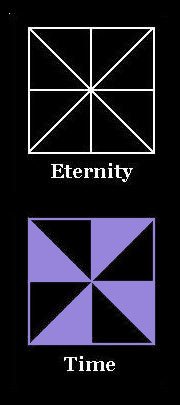





 He is an internationally recognized corporate identity consultant. Based in Hong Kong, his work for clients such as HongkongBank, IBM and Unilever is a major influence in Pacific Rim design.
He is an internationally recognized corporate identity consultant. Based in Hong Kong, his work for clients such as HongkongBank, IBM and Unilever is a major influence in Pacific Rim design.













